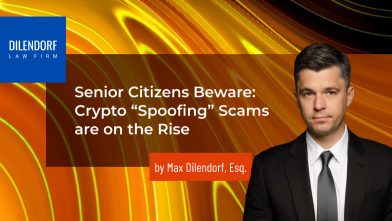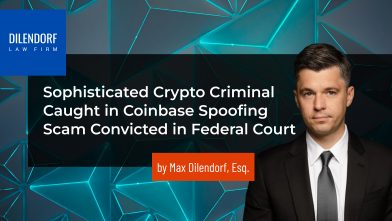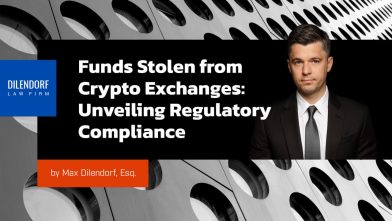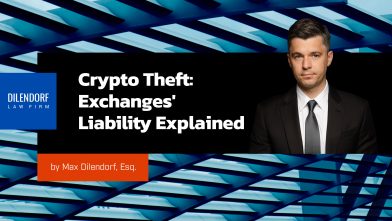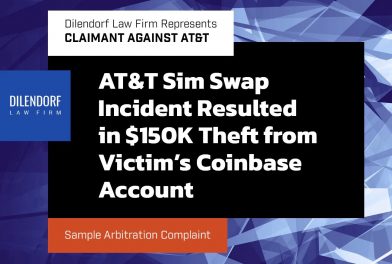The SEC’s Tomahawk Order: ICO Marketing Doomsday?
On August 14, 2018, the U.S. Securities and Exchange Commission (SEC) issued an order against Tomahawk Exploration LLC (Tomahawk) and its principal, David Thompson Laurance (the “Order”), regarding an ICO for Tomahawkcoins that Tomahawk engaged in during mid-2017.
As in its similar orders targeting The DAO and Munchee last year, the SEC found that the virtual tokens being offered by Tomahawk were securities under the Howey test. While the part of the Order discussing unregistered sale of securities, fraud and misrepresentations to investors is rather obvious, the Order also discussed additional issues that significantly affect token sales worldwide. According to the SEC:
- ICO bounty programs involve the sale of securities; and
- Tokens can be treated as equity securities and considered “penny stock.”
These determinations warrant careful review and consideration by companies engaged in token sales in the United States.
The Tomahawkcoin ICO
Tomahawk was a company that Laurance founded for an oil-exploration project in Kern County, California. After the company failed to raise capital traditional way to fund its project, Laurance decided to try to raise money through an ICO for a new virtual token known as Tomahawkcoins (TOM).
Tomahawk claimed that TOM were “backed by profits generated by Tomahawk Exploration LLC an oil producing company.” They would be tradeable on cryptocurrency exchanges, and they could also be converted into shares in Tomahawk.
To help promote the ICO, Tomahawk initiated a bounty program, offering up to 200,000 TOM to third parties who took certain steps to market it, such as “making requests to list TOM on token trading platforms, promoting TOM on blogs and other online forums like Twitter or Facebook, and creating professional picture file designs, YouTube videos or other promotional materials.”
Although no TOM were sold to investors, the company did end up issuing 80,000 tokens through its bounty program.
The SEC Order
The Order includes several findings that should be no surprise to those with a passing familiarity with how U.S. securities laws apply to virtual tokens:
- TOM were securities under the Howey
- As securities, TOM could not be offered or sold in the U.S. without first being registered or qualifying for an exemption.
- The TOM offering materials made several materially false and misleading claims in violation of the securities laws. (These claims are discussed in more detail below.)
- As a result of his personal violations of the securities laws, the SEC imposed a civil penalty of $30,000 on Laurance and reiterated that such penalties are not dischargeable in bankruptcy.
However, the Order also included two determinations that we have not yet seen from the SEC, and these merit a closer look:
- The bounty program constituted a sale of securities; and
- The TOM qualified as equity securities and penny stock.
Bounty Programs as Sales of Securities
“[T]he distribution of TOM in exchange for promotional efforts pursuant to the Bounty Program constituted sales of securities. No registration statements were filed or in effect for the offers and sales of TOM and no exemptions from registration were applicable”
In its Order, the SEC clearly and unequivocally states that the “distribution of TOM pursuant to the Bounty Program constituted sales under Section 2(a)(3) of the Securities Act. . . . The lack of monetary consideration for ‘free’ shares does not mean there was not a sale or offer for sale for purposes of” the registration requirements of U.S. securities laws.
According to the SEC, Tomahawk received value in the form of marketing and promotion of the ICO on blogs and online forums and the creation of a public trading market for TOM:
“Distribution of tokens that are securities in exchange for promotional services to advance the issuer’s economic objectives or create a public market for the securities constitute sales for purposes of Section 5 of the Securities Act and Section 10(b) of the Exchange Act and Rule 10b-5 thereunder”
Because sales of unregistered securities is illegal in the U.S. (unless the sale is exempt from registration), Tomahawk’s bounty program violated the law.
More importantly, even if a company structures its token sale under an exemption from registration in full compliance with securities regulations, token giveaways pursuant to a bounty program could disqualify the entire offering from relying on that exemption resulting in strict liability for the issuer.
Farewell Bounty Programs? Or Hello Bounties 2.0?
Given the SEC’s Order, what are the options for ICO bounty programs to survive going forward? There are essentially two:
- Structure the bounty program to comply with the requirements of whatever exemption is being relied on.[i] For instance, if an ICO relies on Rule 506(c) under Regulation D, the offeror must take reasonable steps to verify that bounty participants in the U.S. are accredited investors and, otherwise, follow 506(c) rules.
- Exclude U.S. residents from participating in the bounty program.
This last option warrants two side notes: First, stating on a website and in offering materials that U.S. participants are not allowed will not be suffcient. Sales of unregistered securities in the U.S. is a strict liability violation. Scienter—in this case, knowledge that some investors are from the U.S.—is not an element of a Section 5 violation.[ii]
Consequently, undergoing a proper Know Your Customer process is critical to ensure that U.S. residents do not, in fact, participate in the bounty program.
Second, the U.S. is not the only country to regulate the offer and sale of securities. Therefore, token sponsors must anticipate, investigate, and comply with similar restrictions in every nation where a bounty program is offered.
Virtual Tokens as Equity Securities and “Penny Stock”
“When offered, TOM was an equity security. . . because it was a security convertible, with or without consideration, into an equity security through its conversion feature. TOM also constituted “penny stock” because they did not meet any of the exceptions from the definition of a “penny stock” in Section 3(a)(51) of the Exchange Act and Rule 3a51-1 thereunder”
This is the first time the SEC has brought up the possibility of treating tokens as penny stock. The commission concluded that TOM was “penny stock” because it was an equity security that:
- Was not an “NMS stock;”
- Traded below $5 per share (i.e., token);
- Was offered by an issuer with net tangible assets and average revenue below regulatory thresholds; and
- Did not meet any other exception from the definition of penny stock.
Such treatment can have dire consequences on token sales and secondary-market trading, because penny stock is subject to additional regulations. Because it is virtually impossible to price penny stocks accurately, the SEC considers them to be a very speculative investment. As a result, the SEC has adopted special rules focusing on the activities of broker-dealers in trading penny stock.
Penny Stock Rules
The SEC rules covering “penny stock” transactions provide, for example, that a broker-dealer must:
- Approve the customer for the specific penny stock transaction and receive from the customer a written agreement to the transaction;
- Furnish the customer a disclosure documentdescribing the risks of investing in penny stocks;
- Disclose to the customer the current market quotation, if any, for the penny stock, including the bid and ask price and the number of shares that apply to such bid and ask price; and
- Disclose to the customer the amount of compensation the firm and its broker will receive for the trade.
To approve an investor’s account, broker-dealer must obtain information regarding the investor’s financial situation, investment experience, and investment objectives; and determine whether the transaction is suitable for this particular investor and whether the investor has sufficient knowledge and experience to evaluate the associated risks. This determination must be delivered to the investor in writing and must be signed by the investor and returned to the broker-dealer.
Bottom line: Penny stock rules are extensive and outside the scope of this article. However, due to additional restrictions and requirements, broker-dealers rarely, if ever, trade penny stock.
Equity Security Rules
Also of concern is the SEC’s determination that TOM were equity securities. Equity securities come with there own special set of rules, including:
- If an equity security is held by more than 2,000 investors (or more than 500 who are not accredited investors) and the issuer of that security has more than $10 million in assets, then the security must be registered.
- Equity securities are subject to the tender-offer rules, restricting the types of buybacks an issuer may engage in.
But, like penny stocks, the details of these special rules are beyond the scope of this article.
What’s next for ICOs and Bounty Programs?
Following the SEC’s Order, projects contemplating token sales in the U.S. need to carefully consider not only whether their token qualifies as a security, but also whether it qualifies as an equity security or penny stock. Projects must also be careful in structuring any bounty program that permits U.S. residents to participate.
As with any legal guidance, practitioners will be looking at facts distinguishing the Tomahawk case from the other token sales. Thus, it is very important to understand the factual specifics of the Tomahawk ICO, including the following details:
- Tomahawk’s principal previously tried to raise money for the same project unsuccessfully a number of times.
- Tomahawk’s online offering materials explicitly linked TOM to equity ownership in the company.
- The ICO website and white paper emphasized that TOM was “directly backed by oil production.”
- The “website and white paper touted the tokens’ potential for significant long-term profits.”
- “Promotional materials represented that TOM investors could trade their tokens for potential profits on a token trading platform, and that they would have the option to convert their tokens into Tomahawk equity at a future date.”
- “According to the ICO website, while Tomahawk prepared to drill the wells, TOM owners would be able to trade their tokens on a decentralized platform ‘right from day #1.’”
- “Tomahawk made numerous false claims about its project, including about acquiring a lease in Kern County and flawless background of Laurence (when in reality he was convicted of securities fraud and filed for personal bankruptcy).
Conclusion
Over the last year, the SEC has become increasingly active in asserting its jurisdiction over virtual token sales. Each time it acts, it clarifies its view of the current state of U.S. securities laws. Yet, each time it acts, it also tends to muddy the waters by creating new questions for lawyers and businesses to wrestle with.
For blockchain companies interested in developing and selling a virtual token in the United States, the SEC’s Tomahawk order should serve as a stark reminder that working with a knowledgeable securities lawyer is critical to the token’s success.
[i] Any bounty program in the U.S. also poses the risk that participants will satisfy the definition of broker-dealer, creating another problem under U.S. securities laws. Any such strategy should be reviewed by qualified counsel.
[ii] SEC v. Calvo, 378 F.3d 1211, 1215 (11th Cir.2004); Swenson v. Engelstad, 626 F.2d 421, 424 (5th Cir. 1980) (the Securities Act imposes strict liability on offerors and sellers of unregistered securities); SEC v. Cavanagh,1 F. Supp. 2d 337, 361 (S.D.N.Y.1998) (to prove a violation of Section 5, a plaintiff need not establish scienter).

